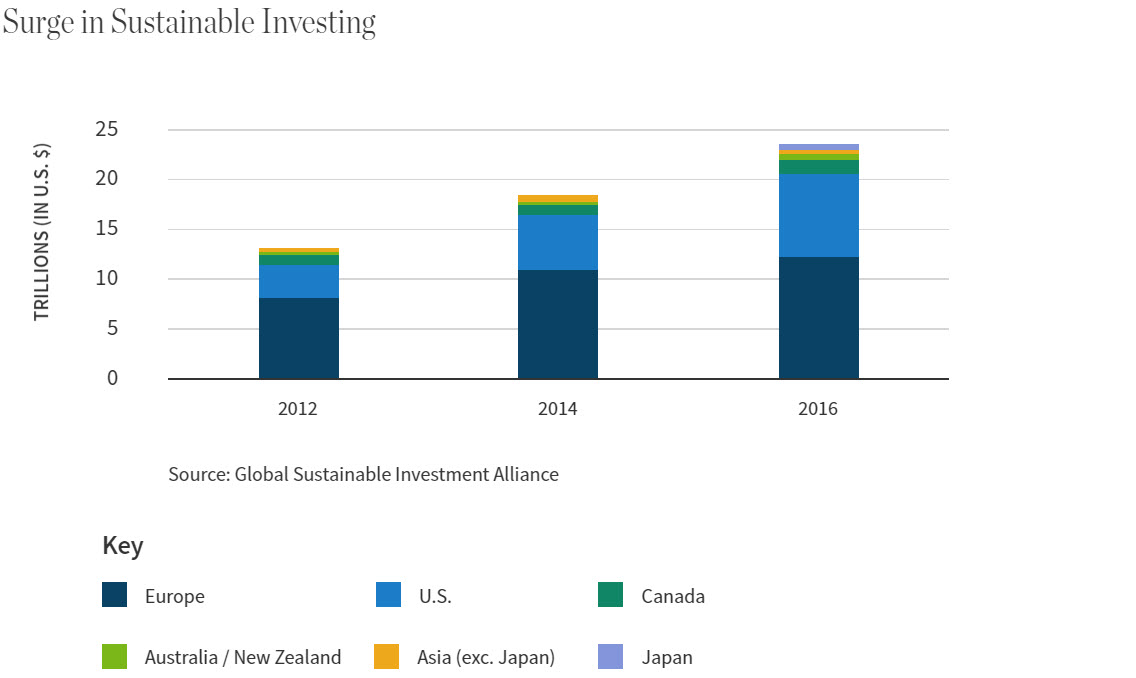Companies across dozens of industries worldwide in 2019 are increasingly seeing sustainability in a new light: as a corporate strategy for long-term returns but also as a critical valuation of their company by their customers, investors, and employees.
Why? Sustainability is having a real impact on their operations, from sales growth and profits to hiring new talent and attracting capital.
"It's on everybody's radar," says Blake Pontius, who leads William Blair's Investment Management sustainable investing initiatives and analysis of environmental, social and corporate governance (ESG) factors. "Corporate sustainability initiatives are evolving beyond risk mitigation to identifying growth opportunities through product and service innovation."

Investors are paying attention. Global Sustainable Investment Alliance data shows that $22.9 trillion of assets were professionally managed under ESG investment strategies in 2016, up from $13.3 trillion in 2012.
Consumers and employees are also paying attention. A Nielsen Global Corporate Sustainability Survey of 30,000 consumers around the world in 2015 reported that 66% were willing to pay more for sustainable brands, up from 55% in 2014. Of millennials surveyed, 73% said they were willing to pay more, up from 50% in 2014.
Companies embrace sustainability top to bottom
Thousands of consumer products are now being produced with sustainability in mind. Sportswear giant Adidas sold 1 million pairs of sneakers made from harvested ocean plastic for $200 a pair the first year they were available. Danish bioscience company Chr. Hansen is developing a probiotic for yogurt to increase shelf life by a week, aiming to cut food waste by 30% and targeting 25% sales growth for its "bioprotection" unit by 2025.*
Corporate giants are also changing their infrastructure. Apple now powers 100% of its facilities across 43 countries with renewable electricity. It pledges to help its manufacturing partners install more than 4 gigawatts of new clean energy by 2020. Walmart doubled the efficiency of its transport fleet by investing in electric vehicles and optimizing rail use.*
"As global environmental and social threats increase, integrating sustainability into core business strategies—and capturing its competitive advantages—becomes ever more critical," according to Turning Point, a review of more than 600 corporations working to meet ESG goals from Ceres, a Boston-based nonprofit. "More companies now understand the business imperative of addressing sustainability risks."
"Customers and employees tend to be more focused on reputation and wanting to philosophically support where they work and who they are buying from with greater and greater understanding of everything that is at stake from unchecked climate change," says Sue Reid, who leads Ceres' climate and energy team.
A broader mandate taking hold?
The United Nations-backed Principles for Responsible Investment (PRI) underscore an ESG view of corporate behavior. Climate change, water, fracking and methane emissions are key PRI environmental "E" issues. But social "S" yardsticks include each company's actions on human rights, labor rights, employee relations and conflict zones. And the PRI's governance "G" yardsticks include scrutiny of executive pay, board diversity, tax avoidance, corruption and cyber security.
Pontius says institutional investors are now asking: What are your ESG credentials? Are you a signatory to the United Nation's PRI? How do you, say, analyze the risks of climate change when you're investing in insurance companies or product safety for pharmaceutical companies? What is the carbon intensity of your portfolio?
"There's a reason why they're asking," he says. "Our institutional investors include pension funds, healthcare organizations, endowments and foundations—all of whom have a long-term focus and see sustainable business practices as strategic to long-term company performance."
A wider lens to examine risk
Losses for world insurers due to climate-related disasters like hurricanes, tornadoes and floods have been rising steadily in the last two decades. But investors are now assessing corporations as a whole through the same lens, rating "transition risk"—meaning future changes in government policies, technology, and international laws seen likely to affect a company's bottom line.
We think it's key to systematically embed ESG analysis in our company research
BLAKE PONTIUS, Director of Sustainable Investing for William Blair Investment Management
"It's the risk of getting behind," explains Reid. "We saw what happened to the coal sector. They were not listening to the signals."
"If you're on the wrong side of that curve it's not going to play out well from a business perspective," she adds, citing auto companies slow to embrace electric vehicles as an example.
Reid notes that ratings agencies like Moody's are increasingly incorporating "downstream" legal risks for companies seen as directly linked to climate change.
Filing for bankruptcy protection in January, California's largest power company PG&E said it faced tens of billions of dollars in potential liability due to the state's wildfires over the past two years, with "the significant increase in wildfire risk resulting from climate change, including the likelihood that future wildfires would result in additional claims."
ESG performance benchmarks in spotlight
So Wall Street is beginning to pay attention to sustainability in a big way.
MSCI, Bloomberg and others now offer ESG indices and data to help investors benchmark ESG performance. Morningstar issues ESG ratings for mutual funds. Stock exchanges are working to enhance ESG reporting. A new array of "green bonds" have entered the fixed-income market.
William Blair analysts regularly meet with companies for their own assessment of ESG factors alongside traditional financial analysis as they assess long-term sustainability. The firm's proprietary online research platform, known as Summit, stores and organizes ESG data including third-party ratings that helps analysts in evaluating companies.
"It is essentially an expanded lens for identifying risks and opportunities," Pontius says. "We think it's key to systematically embed ESG analysis in our company research to provide a more holistic assessment. The link between ESG and financial performance is likely to strengthen from here."
*Adidas news 1/21/19; Ceres Turning Point, 2018; Chr. Hansen reports.
Our Journey to a Sustainable Future
Our newly released Our Journey to a Sustainable Future, features interviews with thought leaders across our firm on how to integrate sustainable and impact investing principles across many of our core business units.


